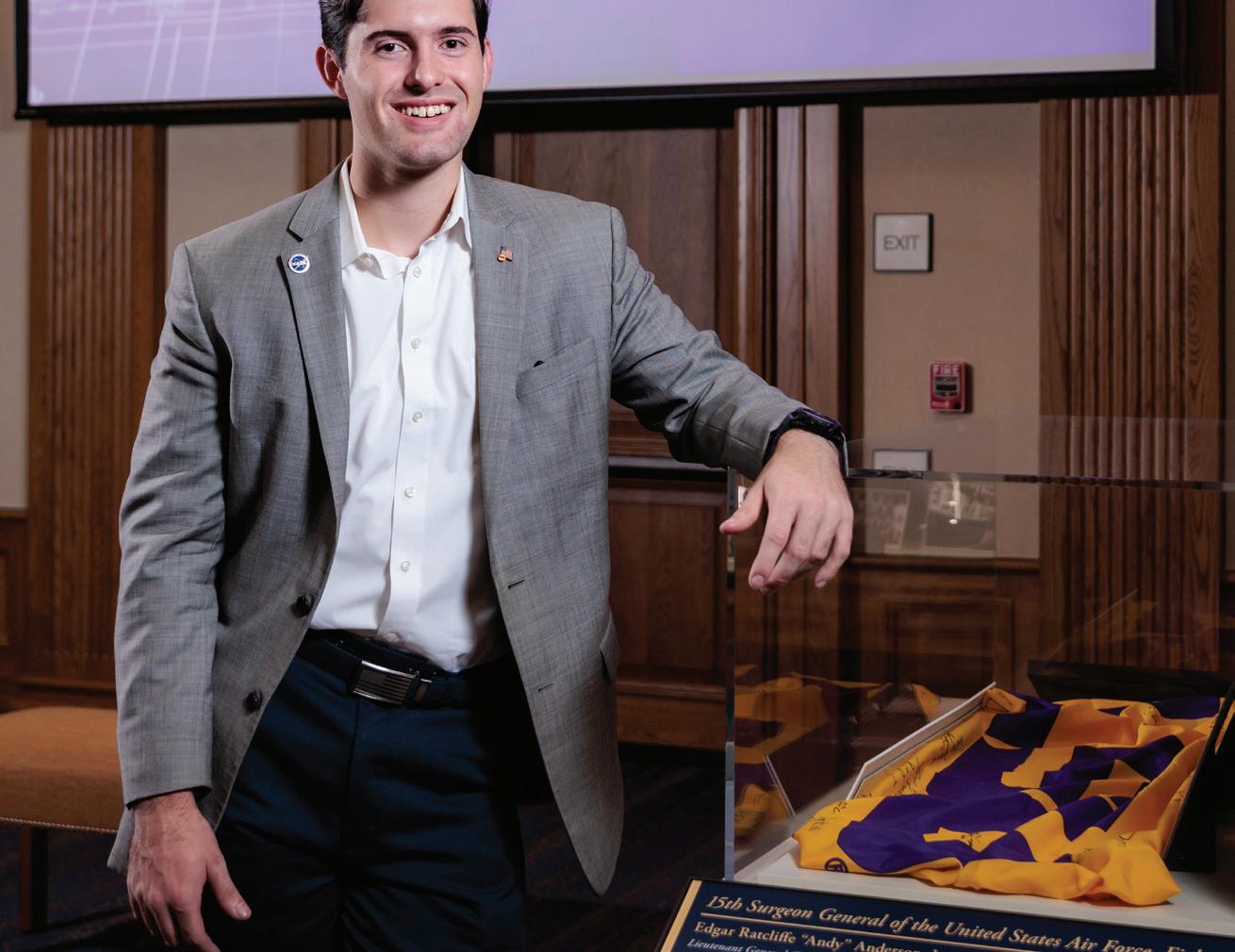










How Capital Region companies are utilizing AI, and best practices you can use.
WHILE ARTIFICIAL INTELLIGENCE and machine learning has been around for years, advances with the technology in the past year have made AI one of the biggest hottest issues of 2023 for just about anyone doing business.
In the Capital Region, AI is no longer a futuristic concept. It is a present-day tool driving change across various sectors. From medical offices to legal firms, industry and marketing, companies in diverse fields across the Capital Region are capitalizing on incorporating AI into their workflows.
Through these stories, we explore the diverse ways in which AI is being integrated into businesses in the Capital Region. From

small startups to established corporations, these stories provide a glimpse into the practical applications of AI in different industries. They highlight the efficiency, innovation and competitive edge that AI can bring, while also acknowledging the challenges and learning curves involved in its adoption.
Beyond just sharing experiences, this guide for AI integration includes advice on evaluating the relevance of AI for different business models, tips for crafting effective AI policies, best practices for reskilling and upskilling employees, and insights on writing clear and effective prompts to maximize AI’s potential.


MARY-PATRICIA WRAY has spent the year exploring artificial intelligence software tools, sifting through them to see which could offer value to Top Drawer Strategies, the lobbying business she started nearly a decade ago.
Through trial and error, Wray has identified myriad uses for various AI applications in her business.
them figures and trends uncovered by AI that back her up.
“You don’t need a cultivated spreadsheet anymore,” she says. “It can come up with interesting data points that you didn’t know existed. I can help a client decide how to use a marketing budget or help clients make decisions that are in their best interest.”
 MARY-PATRICIA WRAY Founder & Owner, Top Drawer Strategies
MARY-PATRICIA WRAY Founder & Owner, Top Drawer Strategies

“There has not been a day in the past four or five months where I didn’t use AI to either help communicate something to a client or analyze data,” Wray says. “What used to take 20 minutes takes five minutes now. It allows me to care more about my work without being so drained.”
“You’re constantly adding a bit of edge here, and that means more revenue and more value for the people you consult.”
One of the biggest takeaways, she says, has been the AI-powered data analysis and visualization tools. While Tableau has been around for years as a data visualization tool, the software has advanced how it takes big data, analyzes it and graphs it.
While in the past, clients had to rely on Wray’s gut and opinions alone when she pitched a strategy, she can now show

AI can also be used to help track bills or predict the outcomes of a piece of legislation, she says. By feeding a program the past voting records of a legislator or transcripts of a committee hearing, AI can help predict how a legislator will vote on a certain issue.
One tool she utilizes even allows her to leave customized voicemails to legislators in her own voice. She uses AI to draft customized messages for constituents, legislators and clients as well as to test the messages without extensive polling. She also says AI allows her interns to take on more complex tasks.
While Wray is already using AI platforms for multiple functions, she still

keeps an open mind for new uses of the technology, which is still evolving. She strives to explore either a new demo software or a training session about once a week.
“Over time, those little advantages add up, whether it’s in client development or communication,” she says. “You’re constantly adding a bit of edge here, and that means more revenue and more value for the people you consult.”
—Holly DuchmannTHE EFFECTIVENESS OF AI depends largely upon a company’s ability to “prompt” the technology to produce the desired output. As such, the fledgling field of prompt engineering is playing an increasingly important role in the AI space.
Prompt engineers are skilled at instructing AI “large language models” to perform various tasks. LLMs are algorithms that can recognize, summarize, translate, predict and generate content using very large datasets.
Colin Raby (left), a senior mechanical engineering student and AI researcher in LSU’s Ogden Honors College, has developed a passion for engineering prompts in such tools as ChatGPT, OpenAI, Stable Diffusion 2 and others. Raby has honed his skill set as a student in one of the nation’s first classes to teach students about LLMs, through the LSU Honors College.
Raby offers these tips for crafting AI prompts to achieve optimal outcomes.
—Sam Barnes
JUSTIN LANGLOISRegional
vice president, Stirling Properties
“I think people worry that it will replace humans, but in our world it has made us better at our jobs.”

JUSTIN LANGLOIS JOKES that he has 10 go-to reasons for using artificial intelligence platforms for help with his work in real estate.
While he has an assistant, he says there are tasks he believes are below their pay grade, such as filing documents, research and writing certain marketing packages. For those tasks, he chooses AI.
“I learned early on that I could use it as another assistant,” he says. “You can train it.”
As a salesperson, he says he doesn’t use the creative side of his brain often and credits AI for helping him prepare marketing materials faster than he previously could.
Earlier this year, he listed and sold a department store in Metairie and challenged himself to use AI as much as he could for writing the marketing package.
“The description of the location on Veterans Boulevard, how many stores the chain operates, the description of the
building and of Metairie as a whole—all from AI,” Langlois says. “I think people worry that it will replace humans, but in our world it has made us better at our jobs. There are just certain things that we shouldn’t be spending our time on.”
He also uses AI to help fact-check real estate data. What used to take him 30 to 40 minutes to analyze himself in Excel, he can now copy and paste into ChatGPT, which spits out answers in seconds.
For Google-specific content, he turns to Bard, Google’s chat-based AI tool. He feeds it information about a deal, as well as previous things he has written, and asks it to write him a testimonial in his voice.
“It compounds—30 minutes here, 40 minutes there,” he says. “In my world, we’re driven by results and AI software has allowed me to take stuff to market way, way faster than in the past.”
—Holly DuchmannBe specific. The more precise the input language and the more context you provide, the better the output. AI is trained on a vast repository of human knowledge and can interpret that data in millions of ways.
“Imagine you’re talking to a new intern who is intelligent and knows a lot of things, but has no frame of reference,” he says. “The more specific the information you provide, the better the AI tool can help you.”
Give context to the request by telling the AI tool who it is, also known as the “persona pattern.” “If you’re a business leader wanting new marketing tactics,” Raby says, “you could prompt the tool by saying, ‘You are an expert in marketing my product online. Currently our business is advertised on Facebook and our website, and we want to expand our sales by 200 percent in the next year. What are some ideas I can use to market our products?’”
Avoid the negative. Tell the AI tool what you want it to do, not what you don’t want it to do. That’s because it might inadvertently ignore the negative instruction and focus on the very thing you don’t want it to do. Instead, stick with the positive.
Instruct the AI tool to ask questions should it require further clarification, also known as a “call and response pattern.” By doing so, you’re giving it permission to ask for more information that will enable it to provide a more valuable output. You might also tell it to restate the purpose of the prompt to ensure that it is interpreting the request correctly. “It’s not a search engine; it’s more of a conversational assistant that works best with twoway communication,” Raby says.
Quantity makes quality. The more information you provide the tool about what you want, the better result you’ll get. That gives the tool the ability to provide more specific answers based upon the information that you’ve provided. “For example, if you need help creating LinkedIn posts, upload the last 20 LinkedIn posts that you made, in the same style, and the result will be exponentially closer to the way that you want it,” he says.
Get creative. These tools haven’t been around for long, so many of AI’s capabilities remain unknown. Practice makes perfect—the more you use AI, the more you’ll become familiar with its capabilities. Perhaps begin with tasks that aren’t time critical. It might not work well in the beginning, but you’ll get better at interacting with the tool and learn what it can do.
THE PLAY STRATEGY: Closed-loop LLM

Neighbors Federal Credit Union, executives have been working on two separate projects since the late summer implementing artificial intelligence technologies into the credit union’s workflow.
For the first, Neighbors is working with Henry Hays and Disrupt Ready to build a closed loop LLM, an internal intranet for the organization, which Brett Reynolds, the credit union’s vice president of marketing, says will help support employees.
“Instead of digging through policy and procedures handbooks, employees can type a question into the language model and get a specific answer,” Reynolds says. “It’s like an intranet on steroids.”
Reynolds, who has been with the organization since 2004, says building a staff database for the credit union has been part of the strategic plan for years and that building it into an intranet would make it easier for staff to use. He’s hoping that the new system will help standardize the way the credit union conducts business.
AI has arrived. Here’s how to adapt your workforce
As businesses across all industries increasingly embrace AI, integrating these cutting-edge technologies and reskilling the workforce for their use have emerged as critical priorities. This guide offers a rough road map for companies aiming to drive innovation and enhance productivity with AI.
—Dillon Lowe ANDREW SCHWARZ Professor, LSU E.J. Ourso College of Business
ANDREW SCHWARZ Professor, LSU E.J. Ourso College of Business
While that project will be used only by the credit union’s staff, the second project is geared externally toward clients. The credit union is integrating AI software with the phone system and its website to help clients find products and services, and in the future conduct smart transactions.
“With this, members can get a lot of the simple things done themselves and it will free our staff to handle more indepth issues that come up in banking,” Reynolds says, noting that the credit union has roughly 80,000 members. “We’re hoping that wait times when people call will be a thing of the past.”
Both projects are on track to be completed in early 2024, and Reynolds says he would like to see AI integrated within the credit union’s data analytics.
“The initial idea is that AI technology can do anything and everything,” Reynolds says. “It’s not going to solve every issue in the world but there are practical applications that can be used to make us more and more efficient.”
—Holly Duchmann
GETTING ANSWERS:
STEP 1: Identify the areas where AI implementation might be most beneficial.
Begin by conducting a comprehensive analysis of your company’s workflow to pinpoint specific areas that could benefit from AI integration.
According to John Snow of Emergent Method, a local consulting firm that has assisted some of its clients with AI adoption, you should first look for tasks that are repetitive, time-consuming or require complex data analysis, as these tasks are more likely to benefit from automation.
“Hone in on the things that take a lot of time and effort to pull off,” Snow says.
STEP 2: Identify the right AI tools for your needs.
Research and evaluate technologies that align with the areas you identified in Step 1, considering factors like
compatibility with existing systems, scalability and user-friendliness. This will take some time, but it’s important to be thorough at this stage.
Also, temper your expectations. “You shouldn’t expect AI tools to be able to do your work with 100% accuracy or fully replace what a person or team can do,” Snow says.
STEP 3: Warm your employees up to the use of AI through education and engagement. Conduct training sessions and workshops to educate your employees about the benefits of the AI tools selected in Step 2, encouraging open discussion along the way.
It’s possible that some employees will be resistant to the change. According to Andrew Schwarz, a professor at LSU’s E.J. Ourso College of Business who teaches a course on AI, effective top-down messaging is crucial in such cases.
“The messaging should be that you’re trying to ‘upskill’ your employees and put them in a place where they can add even more value to the organization,” Schwarz says.
STEP 4: Continue to learn and adapt.
The AI field is constantly evolving, so it’s important that your employees stay abreast of the latest developments and continue to refine the skills they need to use the technologies effectively—a skill set that Schwarz calls “AI literacy.”
What works best for your company today may not be what works best in the years to come. Encourage a culture of innovation in which employees will be empowered to explore new ways of leveraging AI, and establish a feedback mechanism that allows those employees to share their experiences and insights.

 SOTIRIOS STATHAKIS Chief of medical physics, Mary Bird Perkins Cancer Center
SOTIRIOS STATHAKIS Chief of medical physics, Mary Bird Perkins Cancer Center
THE EVOLVING WORLD of artificial intelligence tools has been on Sotirios Stathakis’ radar since he attended a conference in Montreal in 2019 that talked about machine and deep learning.
Four years later, he has helped implement AI technologies at Mary Bird Perkins that are helping doctors pinpoint exactly which organs are being impacted by cancers or could be impacted by chemotherapy and radiation treatments.
Patients need both an MRI and a CT scan for doctors to develop a cancer treatment plan. While the MRI gives doctors information about the soft tissues in the body, CT scans give physicians information on the density of organs and is used to help calculate radiotherapy treatment dosages.
“AI is here and it’s going to be here for a while. The best way to cope with it is to embrace it and understand it.”
creates an AI-generated CT scan. The software, MR-Box by TeraPanacea, eliminates the need to book a second appointment, which could take weeks, and allows a patient to receive treatment much sooner than was previously possible. MR-Box is FDA-approved to produce scans for multiple cancers affecting the brain, abdomen and pelvis.
Like other AIgenerated content, however, the images still need a human eye for approval, Stathakis says.
“You ought to come see it. It’s great.” Lynda M., Resident

But getting the additional scan can be tricky—it requires patients to be in the exact position as the MRI and requires an additional appointment.
This fall, Mary Bird Perkins began using software that takes a patient’s MRI image and
In the future, Stathakis believes AI technology can help hospitals improve their workflows to become more efficient and effective. For example, AI software can analyze thousands of appointments that hospitals have on the books and predict how busy facilities will be in the future and how many staff members will be needed.
“The options are endless,” Stathakis says. “AI is here and it’s going to be here for a while. The best way to cope with it is to embrace it and understand it.”
—Holly DuchmannTHE PLAY STRATEGY: ChatGPT
AMANDA CARLIN joined local architecture firm DNA Workshop as its marketing director in January after spending a half-decade at broadcast station WAFB-TV.
With a creative background, she has strong opinions on content creation and began exploring artificial intelligence tools such as ChatGPT early in the year, shortly after joining the firm.
“If I need help outlining a proposal, I’ll ask its opinion, but I can disagree with the suggestions,” she says.
AI’s real strength is idea generation and helping people organize their thoughts for writing, she says. She estimates that she turns to AI software, mostly ChatGPT, about twice a week when she gets stuck on something and wants a second opinion.

“Everyone was talking about it,” Carlin says. “I thought, ‘Let’s go see what this thing can do.’ I really like using it for certain things and not other things. Some aspects are overhyped.”
While she acknowledges the general fear that it may replace creatives and take away job opportunities, she says she hasn’t produced anything that has been ready to go “as is.” As the only person handling marketing for her firm, she likens the technology to a person or co-worker that she can bounce ideas off.
People should be a little wary of that second opinion, though. She jokes that she can ask ChatGPT for a shortbread cookie recipe but that it may not necessarily give her a good one.
“You have to be careful,” Carlin warns. “AI will talk with so much confidence, but it may not be true. Anything it gives you, you have to not trust it to some degree. It has its place—its place is just not everywhere.”
—Holly Duchmann AMANDA CARLIN Marketing director, DNA Workshop
AMANDA CARLIN Marketing director, DNA Workshop
“I really like using it for certain things and not other things. Some aspects are overhyped.”
THE PLAY STRATEGY: A corporate policy must be malleable in the fast-changing world of AI.
WHAT SHOULD A company consider in writing its policy on artificial intelligence? No matter the approach, the policy should be malleable, since it’s impossible to predict what the future holds for the rapidly evolving technology.
“When it comes to AI, we’re in the bottom of the first inning, or maybe top of the second,” says Henry Hays, owner of DisruptReady in Baton Rouge. “The speed at which this is happening is breakneck, so a corporate policy can become out of date in a relatively brief amount of time.”
Nevertheless, establishing some guardrails that are uniquely tailored to your organization is imperative. No two companies are alike, so an AI policy should be specific to a company’s particular needs. Here are some pointers.
—Sam Barnes
“Be careful about using AI to replace core services. It may be incorporated but it’s not a one-to-one replacement.”
JOHN SNOW Partner, Emergent Method
Be forward thinking
A corporate policy should allow for malleability in the use of AI, addressing things such as structure, technology, processes, metrics, culture and talent acquisition. “You should establish parameters that allow AI to evolve within your organization,” says Andrew Schwarz, a professor in LSU’s E.J. Ourso College of Business.
Identify potential cybersecurity issues
The security of your data is easily the most important issue to address. You should determine your level of security, particularly if using proprietary information to generate output. “AI products such as Open AI, Stable Diffusion and Claude are all ‘in the wild,’ meaning your data will be in the public domain,” Hays says. “In most cases, that’s a hard stop for most companies.”
Establish use rules for employees and leadership
Identify what employees and leadership can and can’t do with AI. “You should specifically identify what AI can and can’t be used for, and whether or not it should be credited when used,” Hays says. “In the legal field, for example, would we want to know if an attorney uses AI in preparing their briefings, court filings, etc.? Those are questions being bandied about right now.”
Create a framework for algorithm auditing
Establish protocols for auditing AI algorithms to avoid inaccurate outputs, also known as “hallucinations.” Most corporations will use outsourced products, so their ability to audit will be somewhat limited. However, that changes when using custom-made algorithms. “You should mitigate ‘hallucinations’ as much as possible in your results,” Hays says.
THE PLAY STRATEGY: PriceLabs, AirDNA, Minut, Autohost
WHEN CHATGPT widely launched last year, Thomas Schumacher was first concerned with how scammers would use the technology to spam his shortterm and vacation rental company River Homes with fake requests on his website as well as on Vrbo and Airbnb.
AI tools also allow Schumacher to respond to guests’ inquiries when he’s unavailable.

“Are these real people behind these requests? Scam artists are getting more advanced to send messages and requests that seem legitimate,” says Schumacher, who manages homes in St. Francisville, Baton Rouge and the False River area in New Roads.
But with time, he—like many other executives in Baton Rouge—began asking: How can artificial intelligence benefit my business?
Software like PriceLabs and AirDNA help short-term rental owners with price optimization by looking at the market and seeing what other homes are charging as well as demand levels. Schumacher can also input a calendar of local events—such as the St. Francisville Food & Wine Festival and the LSU football season—to help predict demand and adjust prices accordingly.
“We want our homes to be filled with quality guests,” Schumacher says. “AI can sift through reservations and catch red flags. If there’s only one guest listed, our AI will message them and confirm that it’s one person staying at the home.”
There should be some clear guardrails around which processes or tasks can be automated, and which cannot. Automation implies that a task is performed entirely without human involvement. Recognize that AI can help optimize efficiency, but be careful of replacing people or quality. “Think about how much your business relies on human interaction,” says Emergent Method partner John Snow. “Be careful about using AI to replace core services. It may be incorporated but it’s not a one-to-one replacement. Think of AI as being an additive and supportive instead of replacing. In general, recognize the opportunity, but proceed with caution.”
“We receive requests in the middle of the night, 3 a.m., from people all over the country,” he says. “People want to know what the distance is from the houses to the LSU stadium or the school itself. If we don’t answer within five minutes, that guest may move on to another home listing. When I’m sleeping, AI allows me to get a quick response to them.”
With short-term rentals, the more often listings are updated, the higher it appears on search results, he says. For the past few months, he’s used an AI plug-in on River Homes’ website that helps with home descriptions and suggests which photos should be the primary photo for the listing.
Another tool he uses corrects typos and reconfigures the language of blog posts he dictates while driving. After reviewing the post, he hits “publish.” In the homes themselves, a smart lock system generates new codes for the locks every two weeks.
“Within smaller markets, AI is still useful,” he says. “You just have to be more personalized in your approach with the technology.”
—Holly DuchmannIn the same vein, there should be guidance around which processes or tasks can be augmented or enhanced with AI, and which cannot.
“The thing that businesses really need to think about when it comes to AI is to not start thinking, ‘We have to use this,’ or that it’s a silver bullet,” Snow says. “Think about the things that employees and teams spend time on, or struggle with, and ways that task can be done more efficiently—like data analysis and idea generation. It’s about identifying the problem instead of just jumping to the solution, not just using technology to use technology.”
 THOMAS SCHUMACHER Owner, River Homes
THOMAS SCHUMACHER Owner, River Homes
“AI can sift through reservations and catch red flags. If there’s only one guest listed, our AI will message them and confirm that it’s one person staying at the home.”
As federal regulations around AI are formulated, corporations will need to establish policies to ensure compliance. “We are headed toward more regulation in this field, so the markets will need to adjust,” Hays says.
No matter its size, a company should establish guidelines for the creation of an internal digital assets team. Ideally, the team should comprise a small group of employees genuinely interested in emerging technologies.
“A digital assets team can help your company craft its approach and strategy to AI,” Hays says. “As a benefit, you can move and adapt with
changes. For a small- to mediumsized company, it can actually become a strength over larger companies who are often slow to change. Having such a team is also a great way to attract the younger generation.”
Establish the means and methods for training your workforce in AI, specific to each employee’s role. Ultimately, everyone will need a certain level of training. “We’re about to undergo the greatest change we’ve ever seen in the way we do work,” Hays says.
Holly Duchmann contributed to this report.



tip sheet
How might AI reshape business in 2024? What the technology itself says.
How will artificial intelligence impact business in 2024? Who better to ask than AI itself? In mid-November, we asked GPT-4 to highlight ways AI might leave its mark on these 10 business sectors in the coming year. Its response came with this self-generated disclaimer: “Each of these sectors will likely face unique challenges and opportunities as they integrate AI into their operations. The specifics will depend on the advancements in AI technology, regulatory frameworks, and the sectors’ readiness to adopt these changes.”
Banking and Financial Services
• Enhanced customer experience through personalized financial advice using AI-driven chatbots.
• Improved fraud detection and security using AI algorithms that can detect anomalies.
• Streamlined operations and cost savings from automated processes and decision-making.
Oil and Gas
• Increased operational efficiency through predictive maintenance of equipment.
• Enhanced oil exploration with AI algorithms analyzing geological data to predict new oil field locations.
• Optimization of fuel supply chains with AI-powered logistics.
Petrochemical
• AI will likely contribute to better demand forecasting and production planning.
• Enhanced safety with AI monitoring systems detecting potential hazards.
• Improved efficiency in the chemical manufacturing process using AI to optimize conditions.
Construction
• Project management advancements using AI to predict project delays and optimize resource allocation.
• Safety improvements with AI surveillance monitoring job sites.
• Cost savings through AI-driven predictive maintenance of construction machinery.
Retail
• Personalized shopping experiences with AI analyzing shopping behaviors to predict customer needs.
• Inventory management optimizations using AI to predict stock levels.
• Automation of customer service with AI chatbots.
Health Care
• Improved diagnostic accuracy with AI algorithms interpreting medical images.
• Personalized treatment plans generated by AI based on patient data.
• Streamlining administrative tasks in health care facilities using AI for more efficiency.
between chemical manufacturer BASF and LSU in the use of artificial intelligence technology could expand in the coming months. Kerr Wall, digitalization manager at BASF’s monomers division in Geismar, says the collaborative team recently applied for $300,000 in grants from the National Science Foundation and the Louisiana Board of Regents’ Industrial Ties Research Subprogram.

That’s in addition to the initial funding BASF put up to initiate the collaboration. If awarded, the new grant money would expand the AI initiative by paving the way for full-time graduate students to work as BASF interns.
Since 2022, BASF has been working with LSU chemical engineers to better understand and predict its own production ebbs and flows. Wall and Eric Dixon, a digitalization expert at BASF, meet regularly with José Romagnoli and Xun Tang, professors in LSU’s chemical engineering department, to go over their results.
“BASF has a lot of production data, but it can be a challenge to understand the underlying dynamics,” Tang says. “Through this collaborative project, we can learn directly from the data to identify patterns. Then we can use what we learned to predict new conditions to optimize and maintain the operation of the system. This way, we can help BASF automate and optimize their plant, and also improve the yield and quality of their product while reducing costs.”
BASF has already made significant headway in creating a streamlined approach to predicting quality or process outcomes through the identification of
Manufacturing
• Increased efficiency through AI-powered automation and robotics on production lines.
• Predictive maintenance to minimize downtime.
• Quality control enhancements with AI visual inspection systems.

data “clusters.” Ram Krishna, a chemical engineer participating in BASF’s professional development program for engineers, is performing much of the legwork. “We had a hypothesis that said if we can split our process data into clusters (smaller data sets) we should be able to make better models and predict outcomes with higher accuracy,” Dixon says.
They are then using those models to make recommendations, by word of mouth, to various process units within the Geismar plant. BASF hopes to eventually use clustering algorithms to determine the optimal cluster model, then input the data into the model. That will, in turn, enable BASF to better predict output variables or suggest optimization parameters.
BASF could apply the approach to a variety of its processes, such as steam usage, wastewater creation, wastewater quality, etc., as well as use AI to achieve sustainability goals. “This would be useful in all 20-plus BASF plants and could have a significant impact on the optimization of our processes,” Wall says. “Chemical manufacturing is complex. Operating conditions can change minute to minute and there is a lot of data to mine. Big data gives a great opportunity to optimize our processes and become more predictive to improve our yields and our utility usage.
“This will make us more energy efficient and support our global value of producing chemicals for a sustainable future.”
—Sam BarnesReal Estate
• AI-driven property valuation models improving accuracy in pricing.
• Enhanced customer service with virtual AI assistants for property viewing.
• Predictive analytics to identify real estate market trends.
Insurance
• AI for personalized insurance products based on customer data analytics.
• Faster claims processing through AI, leading to improved customer satisfaction.
• Fraud detection improvements using AI pattern recognition.
Technology
• Acceleration of innovation with AI assisting in research and development.
• AI ethics and governance will likely become a major focus, with AI being used to audit and ensure compliance with standards.
• Enhanced cybersecurity with AI systems identifying and responding to threats in real time.